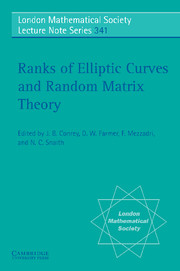Book contents
- Frontmatter
- Contents
- Introduction
- FAMILIES
- Elliptic curves, rank in families and random matrices
- Modeling families of L-functions
- Analytic number theory and ranks of elliptic curves
- The derivative of SO(2N +1) characteristic polynomials and rank 3 elliptic curves
- Function fields and random matrices
- Some applications of symmetric functions theory in random matrix theory
- RANKS OF QUADRATIC TWISTS
- NUMBER FIELDS AND HIGHER TWISTS
- SHIMURA CORRESPONDENCE, AND TWISTS
- GLOBAL STRUCTURE: SHA AND DESCENT
- Index
Elliptic curves, rank in families and random matrices
Published online by Cambridge University Press: 10 November 2010
- Frontmatter
- Contents
- Introduction
- FAMILIES
- Elliptic curves, rank in families and random matrices
- Modeling families of L-functions
- Analytic number theory and ranks of elliptic curves
- The derivative of SO(2N +1) characteristic polynomials and rank 3 elliptic curves
- Function fields and random matrices
- Some applications of symmetric functions theory in random matrix theory
- RANKS OF QUADRATIC TWISTS
- NUMBER FIELDS AND HIGHER TWISTS
- SHIMURA CORRESPONDENCE, AND TWISTS
- GLOBAL STRUCTURE: SHA AND DESCENT
- Index
Summary
This survey paper contains two parts. The first one is a written version of a lecture given at the “Random Matrix Theory and L-functions” workshop organized at the Newton Institute in July 2004. This was meant as a very concrete and down to earth introduction to elliptic curves with some description of how random matrices become a tool for the (conjectural) understanding of the rank of Mordell-Weil groups by means of the Birch and Swinnerton-Dyer Conjecture; the reader already acquainted with the basics of the theory of elliptic curves can certainly skip it. The second part was originally the write-up of a lecture given for a workshop on the Birch and Swinnerton-Dyer Conjecture itself, in November 2003 at Princeton University, dealing with what is known and expected about the variation of the rank in families of elliptic curves. Thus it is also a natural continuation of the first part. In comparison with the original text and in accordance with the focus of the first part, more details about the input and confirmations of Random Matrix Theory have been added.
Acknowledgments. I would like to thank the organizers of both workshops for inviting me to gives these lectures, and H. Helfgott, C. Hall, C. Delaunay, S. Miller, M. Young and M. Rubinstein for helpful remarks, in particular for informing me of work in process of publication or in progress that I was unaware at the time of the talks.
- Type
- Chapter
- Information
- Ranks of Elliptic Curves and Random Matrix Theory , pp. 7 - 52Publisher: Cambridge University PressPrint publication year: 2007
- 2
- Cited by

